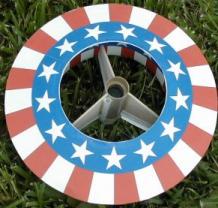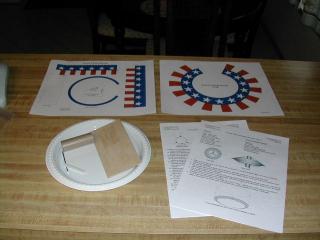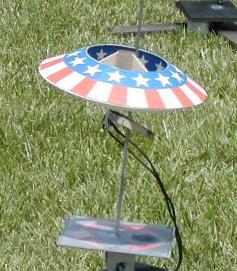Art Applewhite Rockets Flying Saucer 24mm (9")
Art Applewhite Rockets - Flying Saucer 24mm (9") {Kit}
Contributed by Dick Stafford
| Manufacturer: | Art Applewhite Rockets  |

(Contributed - by Dick Stafford - 06/20/02)
Brief:
This Flying Saucer has a 24mm motor mount and is designed to fly on C11-0 and
D12-0 motors. It is comprised mainly of pre-printed card stock and splits into
two parts at apogee, both of which use tumble recovery. At the time of writing,
this saucer is also offered in USAF and Smiley Face print schemes, or in blank
card stock.
Construction:
Components:
- Two preprinted card stock sheets comprise the top and core assembly of the saucer.
- One 9" plastic picnic plate comprises the bottom.
- One 2.75" BT-50 motor tube
- One 2.75" motor hook
- One 3/16" launch lug
- 3/32" basswood fin stock

Tools and materials required:
- Scissors
- Exacto knife
- Elmer's white glue
- Rubber cement
- Clear enamel (RUS-TOLEUM Crystal Clear or equivalent)
- Double-sided tape
- 150 grit sandpaper
The construction of this kit is quite simple and the whole rocket can be built in one evening. I saved the painting for the next day. The instructions come on four sheets and include illustrations and the required templates. They are detailed, but should be read carefully from start to finish before starting construction.
You first cut out the top and core pieces and glue them together using the printed tabs, similar to any paper shroud. An inner ring is attached to the core, and the core is glued into the top section. These steps use white glue, and, of course, the glue must dry between each step. Although I got it together fine, I think most grade-schoolers could have done as well. Using a provided template, a hole the size of the paper core is cut in the plate. The template is supposed to be attached temporarily with double-sided tape, but I just used clear tape. The plate is then glued to the saucer assembly with rubber cement. I again deviated and used Liquid Nails. The results were OK, but rubber cement would have worked better and I recommend you follow the instructions on this point. This completes the body of the saucer.
To assemble the fin can, you mark, cut and sand the fins. These are attached to the motor tube like any other fins. You optionally can add card stock spin tabs, which I did. The launch lug is added and the fin unit is complete. Make sure you glue the launch lug on so that it will not interfere with the spin tabs. Oh, I left off the motor hook since I plan to fly this baby on the longer E9 motor.
The last step is to sand the tip of the fins so that the fin assembly slides into the core section of the saucer.
Finishing:
Finishing consists of spraying the printed top and core of the saucer with
clear enamel. You have to make sure not to get this on the plastic plate as the
paint might damage it. I guess you could paint the fin can, but I elected to
leave it naked.
Construction Rating: 4 out of 5
Flight:
For the first flight, I decided to stick with the recommended D12. Since I left
out the motor hook, I had to use masking tape on the motor. That's about all
the prep that is required. The saucer spun on the way up and reached an
impressive altitude. It did not separate at apogee. Instead, it backslid all
the way down and landed four feet from the pad. Pretty good since there were 5+
mph winds.
Against Art's advice not to try a motor with an delay/ejection charge, I went crazy and stuffed in an E9-6. This time the saucer really tore off the pad. I couldn't detect the spinning motion, but it did wobble a bit. In spite of the extra altitude, the saucer impacted on its side before the delay was done. Luckily, there was no charring, landing damage or grass fires! Way cool flight!
After thinking about why my saucer didn't separate into two pieces, I came up with this explanation. When I sanded the fin unit to fit, it slid in easily in one position. If you turn it +/- 45 degrees it binds a little. So, I think the spinning motion makes the two section twist relative to one another until it hits that spot.
Flight Rating: 5 out of 5
Summary:
This is a simple, fun kit. It flies really great, and is pretty tough, tougher
than you might think for cardboard!
Overall Rating: 5 out of 5
 |
 |